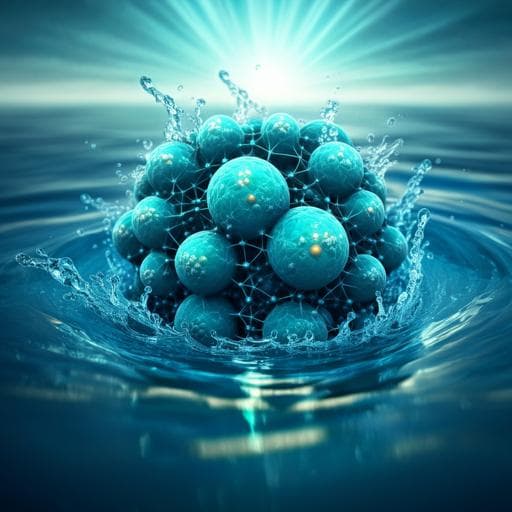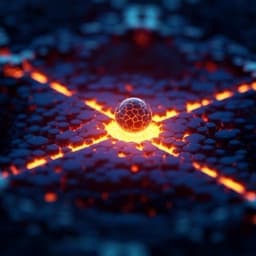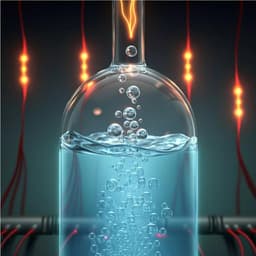
Chemistry
A metal-free photocatalyst for highly efficient hydrogen peroxide photoproduction in real seawater
Q. Wu, J. Cao, et al.
Discover how researchers, including Qingyao Wu and colleagues, have developed a groundbreaking metal-free photocatalyst that produces H₂O₂ at an unprecedented rate of 1776 µmol g⁻¹h⁻¹ in real seawater, defying limitations posed by salt on conventional photocatalysts. This innovative approach leverages a phenolic condensation process, paving the way for more effective H₂O₂ production methods.
~3 min • Beginner • English
Introduction
Hydrogen peroxide (H2O2) is a valuable oxidant with broad applications in medicine, chemical industry, and environmental remediation. Conventional H2O2 production methods (anthraquinone process and electrochemical synthesis) are energy-intensive and generate toxic by-products, motivating green, sunlight-driven routes that reduce O2 with H2O (artificial photosynthesis). Utilizing abundant seawater for photocatalytic H2O2 production could mitigate freshwater scarcity and reduce system costs. However, existing photocatalysts face challenges including poor light absorption, mismatched band structures, slow electron transfer, reliance on sacrificial agents, and, crucially, severe deactivation in saline media where salts consume photocarriers and promote side reactions. Carbon dots (CDs) have emerged as co-catalytic sites and effective electron acceptor/donor materials that can enhance photocatalysis. The research question addressed here is whether a metal-free organic polymer composite incorporating CDs can overcome salt-induced deactivation and achieve efficient, stable H2O2 photoproduction directly in real seawater, and what mechanism underlies any salt-enhanced performance.
Literature Review
Prior studies have explored inorganic and organic photocatalysts for H2O2 generation under visible light, including Au/BiVO4, g-C3N4-based frameworks, and resorcinol–formaldehyde resins. Limitations have included inadequate visible/NIR absorption, improper band edge positions for two-electron oxygen reduction (ORR) and water oxidation (OER), low charge transfer rates, and the need for sacrificial agents. Salinity commonly deactivates catalysts or diverts photogenerated charges, hindering seawater applications. Carbon dots have been used as co-catalysts/electron mediators to improve charge separation and interfacial kinetics in various photocatalytic systems. Building on these insights, the present work integrates CDs into a phenolic polymer network to address light harvesting, band alignment, and carrier dynamics specifically under seawater conditions.
Methodology
Materials: Procyanidins (PC), 4-methoxybenzaldehyde (MB), Na2CO3, HNO3, and seawater from the Yellow Sea. Synthesis of CDs: Electrochemical method using two graphite rods as anode/cathode in ultrapure water at 30 V for 20 days under strong stirring. The black dispersion was filtered through a four-stage membrane system (particle diameter < 50 nm), then freeze-dried to obtain CD powder. Synthesis of PM-CDs-x catalysts: CDs (0, 10, 30, 60, 100 mg in 10 mL water) were mixed with PC (0.5 g) and Na2CO3 (0.1 g), followed by addition of MB (0.9 mL). The mixture was sealed and heated at 80 °C for 48 h to form a gel, washed with ethanol/water, rapidly frozen (liquid nitrogen, −196 °C, 10 min), and freeze-dried (−53 °C, 0.113 mbar) to yield crosslinked organic semiconductor PM-CDs-x (x denotes CD mass). Characterization: TEM/HRTEM (size 6–16 nm CDs; 0.21 nm lattice spacing for (100) graphitic plane), FT-IR, XRD, XPS, elemental analysis, BET surface area. Optical/electronic: UV–vis absorption and Tauc plots (Eg ≈ 1.94 eV for PM-CDs-30), UPS to determine Evb (5.98 eV vs vacuum) and derive Ecb (4.04 eV vs vacuum), band alignment vs RHE potentials. Electrochemical/photoelectrochemical: EIS for charge transfer, transient photovoltage (TPV) for carrier dynamics under various conditions (with/without salts; O2/N2; solvent effects), RDE/RRDE in O2-saturated seawater to evaluate ORR electron transfer number. EPR with DMPO spin trapping for •OH and O2•− detection. Photocatalytic tests: Conducted in a multichannel photochemical reactor (λ ≥ 420 nm). Typical test: 10 mg catalyst in 20 mL seawater (or pure water) in a 50 mL quartz bottle, open to air, room temperature, 5 h, 180 rpm. Variables: illumination time (5–96 h), rotation speed (40–200 rpm), oxygen partial pressure (0–16 mL O2 injected into sealed system), atmosphere (N2- or O2-saturated), monochromatic excitation (365, 420, 535, 620 nm) for AQY, scavengers (2 mM AgNO3, EDTA-2Na, tert-butyl alcohol, benzoquinone). Stability: five consecutive cycles (5 h each), with washing/drying between runs; post-reaction SEM/TEM/XPS. O2 evolution: water with AgCl under N2 purge in sealed system, analyzed by GC. Quantification: H2O2 measured by titration with 0.1 M KMnO4. Modeling: A thermodynamic-kinetic model considered OER, ORR, and oxygen diffusion contributions, deriving expressions for rates r1 (OER), r2 (ORR dependent on P_O2 and rotation speed ω), and r3 (diffusion limit), to predict dependence of H2O2 production on ω and P_O2 in seawater and water; compared with experiments. Data analysis: One-way ANOVA with Tukey–Kramer post hoc; triplicate measurements.
Key Findings
- A metal-free composite photocatalyst (PM-CDs-30) comprising procyanidins–methoxybenzaldehyde polymer and embedded carbon dots achieves high H2O2 production in real seawater: 1776 µmol g−1 h−1 under visible light (λ ≥ 420 nm; intensity 34.8 mW cm−2). - Activity enhancement vs pure water: For CD-containing polymers, seawater yields are ~1.1–1.5× higher than in pure water; PM-CDs-30 shows 1776 µmol g−1 h−1 (seawater) vs 1340 µmol g−1 h−1 (water). - Improvement vs pure polymer: Adding CDs boosts activity up to ~4.8× relative to PM-CDs-0 in seawater. - Energy conversion metrics: Apparent quantum yield reaches 0.54% at 630 nm in seawater; solar-to-chemical conversion efficiency is 0.21% in seawater. - Stability: After five cycles, PM-CDs-30 retains 1725 µmol g−1 h−1, with morphology largely preserved; slight CD aggregation observed by TEM; XPS indicates adsorbed Na and Cl from seawater, with C 1s and O 1s largely unchanged. - Spectroscopy/band structure: PM-CDs-30 has Eg ≈ 1.94 eV; Evb = 5.98 eV and Ecb = 4.04 eV (vs vacuum), positioning suitable for two-electron ORR to H2O2 and water oxidation. - Mechanistic evidence: EPR detects O2•− under illumination but no •OH; scavenger tests show H2O2 production is inhibited by AgNO3 (electron scavenger), enhanced by EDTA-2Na (hole scavenger), and suppressed by BQ (O2•− scavenger); TBA (•OH scavenger) has negligible effect. - TPV shows that adding salts (NaCl, MgCl2, CaCl2) increases photovoltage magnitude and produces a pronounced negative region for CD-containing samples, indicating enhanced electron trapping by CDs (electron sink effect) and prolonged charge separation. - Atmosphere dependence: H2O2 production decreases in N2-saturated seawater and increases in O2-saturated seawater, confirming reliance on dissolved O2; TPV in acetonitrile shows electron consumption by O2 and increased electron signal upon adding water (hole scavenger). - Electrochemical ORR pathway: RDE/RRDE in O2-saturated seawater gives an electron transfer number of ~1.82, supporting a predominant two-electron ORR to H2O2; disk/ring response under illuminated N2-saturated seawater indicates a four-electron OER to O2 on the hole side. - Kinetic modeling: Predicted increases of H2O2 production rate with rotation speed and oxygen partial pressure match experimental trends in seawater and water; calculated rates exceed experiments due to neglect of H2O2 decomposition in the model. - Salt effects: Within seawater-relevant concentrations, NaCl, MgCl2, and CaCl2 all enhance H2O2 yields, with statistical significance (ANOVA/Tukey).
Discussion
The study demonstrates that incorporating carbon dots into a phenolic polymer network yields a metal-free photocatalyst that not only withstands but benefits from seawater’s ionic environment. The CDs act as electron sinks; in seawater, metal cations ionize surface functional groups (e.g., carboxyl, hydroxyl, carbonyl) on CDs, increasing their electron-withdrawing character and the energy barrier for electron back-transfer. This enhances electron trapping, suppresses recombination with holes, and promotes efficient two-electron oxygen reduction to H2O2 on CD sites, while holes on the polymer oxidize water to O2. Band alignment (Eg ≈ 1.94 eV; Ecb above the ORR potential and Evb positioned between O2/H2O and H2O2/H2O redox levels) supports the concurrent ORR and OER half-reactions under visible light. The thermodynamic-kinetic model, validated experimentally, clarifies the roles of oxygen availability and mass transport (rotation speed, partial pressure) in governing rates, with the ORR/diffusion steps setting the pace under the studied conditions. Collectively, the mechanism explains the unusual observation that activity in seawater surpasses that in pure water for CD-containing polymers, addressing the long-standing challenge of salt-induced deactivation and highlighting a practical route to solar H2O2 generation from seawater.
Conclusion
A metal-free organic polymer–carbon dot composite (PM-CDs-30) was developed that achieves high-rate H2O2 photoproduction directly in real seawater. The catalyst delivers 1776 µmol g−1 h−1 H2O2, an up to 4.8-fold improvement over the polymer alone, with AQY of 0.54% at 630 nm and SCC efficiency of 0.21%, along with good cycling stability. Mechanistic investigations (TPV, EPR, scavenger tests, PEC, and RDE/RRDE) support a parallel two-electron ORR on CD sites and four-electron water oxidation on the polymer, with seawater cations amplifying the CDs’ electron sink effect to extend charge separation lifetimes. A thermodynamic-kinetic model captures dependencies on oxygen partial pressure and mass transport and agrees with experiments. These findings open avenues for practical seawater-to-H2O2 solar conversion and inform the design and optimization of metal-free photocatalysts that leverage ion–surface interactions. Potential future work includes scaling to larger reactors, long-term durability in diverse seawater matrices, systematic tuning of CD surface chemistry and ion interactions, and integrated systems for on-site H2O2 utilization.
Limitations
- The thermodynamic-kinetic model does not account for H2O2 decomposition, leading to calculated rates exceeding experimental values. - Long-term tests show slight aggregation of CDs after extended irradiation and adsorption of seawater ions (Na, Cl) on catalyst surfaces, which may affect durability. - H2O2 accumulation plateaus and slightly decreases after ~72 h, suggesting activity decrease and/or concurrent decomposition. - Performance was evaluated with seawater from a single source (Yellow Sea); variability across different seawater compositions was not comprehensively assessed.
Related Publications
Explore these studies to deepen your understanding of the subject.







